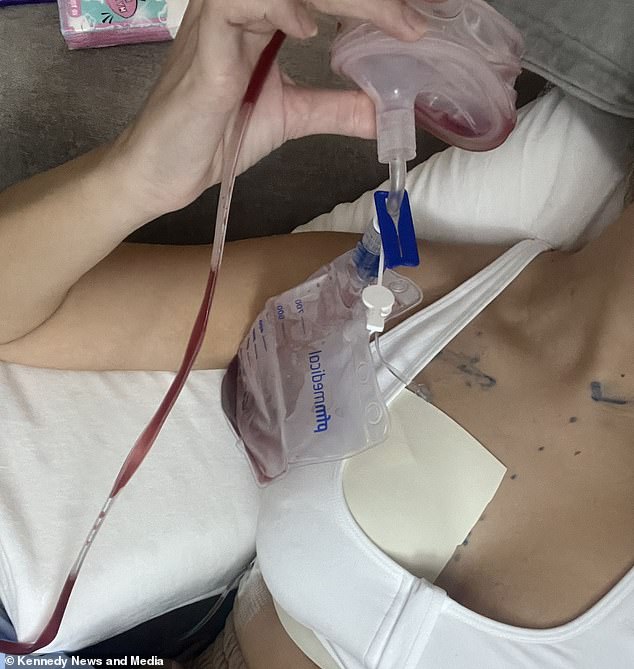Doctors told me my troubling symptom was “just hormones” — it was actually cancer
A 26-year-old cancer patient was outraged after a GP dismissed her bleeding nipple and breast lump as ‘just hormones’ – telling her she ‘didn’t meet the criteria’ for breast cancer.
However, a subsequent biopsy performed by a breast clinic revealed that the business manager actually had early-stage breast cancer, requiring her to have a mastectomy to prevent the spread of the disease.
Courtney Bailey from Newcastle is now awaiting further test results which will determine whether or not she is cancer free.
She said: ‘I kept being told I was too young. We need to change the mentality that you are too young to have cancer because anyone can have it. I got the feeling that it was nothing.’
According to Cancer Research UK, the number of breast cancer cases among people aged 25 to 49 has risen by almost a fifth since 1990.
Ms Bailey’s concerns began in June when she noticed a blood-stained drop of water on her left nipple after getting out of the shower.
She visited her GP the next day, but claims she was told she ‘didn’t meet the criteria’ to be referred and that her symptoms were likely due to a ‘hormone imbalance’.
Days later she discovered a small, hard lump under the same nipple and returned to the GP – but even after further investigation she was still told there was ‘no cause for concern’.
Courtney Bailey, 26, immediately became concerned when she noticed a blood-stained drop of water on her left nipple after a shower in June

The Newcastle business manager visited her GP the next day but claims she was told she ‘didn’t meet the criteria’ to be referred and that her symptoms were likely a ‘hormone imbalance’. But as a precaution, a biopsy revealed precancerous cells lodged in her milk ducts
Mrs Bailey was then referred to a breast clinic where she was told she probably had a cyst or blocked milk duct, which would go away on its own.
However, a precautionary biopsy revealed precancerous cells lodged in her milk ducts and she was diagnosed with Ductal Carcinoma In Situ (DCIS) – early breast cancer.
According to Cancer Research UK, around 7,300 women are diagnosed with DCIS in the UK every year. It means that some cells in the lining of the milk ducts begin to multiply rapidly, as they do when cancer develops.
Many people have no symptoms when diagnosed and symptoms are often noticed during routine mammograms as part of the UK breast screening programme.
However, a small number of patients will notice a lump in the breast and/or discharge from the nipple which may be blood-stained, and possibly a rash on the nipple which may be red and scaly.
Ms Bailey’s biopsy also revealed precancerous cells outside the milk ducts and in the rest of the breast. To prevent the disease from spreading further, she opted to have her left breast removed and received an implant.
Now she is waiting for final test results to see if any cancer remains in the tissue, and is urging other women to urge doctors to be referred if they spot anything worrying.
‘Since I was diagnosed, I no longer have any feelings about it. I mentally checked it out a little bit. “When you hear that word ‘cancer,’ you immediately think of death and I’m not going to have any hair anymore,” she said.

Ms. Bailey opted to have a single mastectomy on her left breast when doctors discovered even more precancerous cells in her breasts and she was immediately implanted.

Ms Bailey said she saw the mastectomy as a ‘life or death decision’ – and immediately dismissed any concerns about self-image after her diagnosis

Ms Bailey is still waiting for her test results to determine if she is ‘cancer free’ – but wants her diagnosis to inform others that cancer can affect anyone at any age
‘Originally the plan was to do a lumpectomy and the grade of the cancer would determine whether I needed further treatment.
‘But after they found more precancerous cells, I told my consultant that it would make more sense to do a mastectomy, and she agreed.
‘Because performing two lumpectomies in my natural breast would not have created any shape for me.’
Ms Bailey said she saw the mastectomy as a ‘life or death decision’ – and immediately dismissed any concerns about self-image following her diagnosis.
She said: ‘It really reassured me because everything has been taken out and I know they haven’t missed anything.
‘When I was diagnosed, my outlook on life changed. Things like your body image become so small.”
Ms Bailey wants her diagnosis to inform others that cancer can affect anyone at any age.
‘The GP and nurses followed the National Health Service criteria. But you can’t classify someone’s health based on his or her age. Anyone can get cancer,” she said.
‘If there is something unusual about your body, you have the right to ask for a referral.
‘If people don’t take you seriously, it increases stress. I’m lucky that I actually had symptoms and that it was caught so early.
‘I never thought I’d have one breast at the age of 26, but I’m proof it can happen to anyone.’
